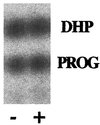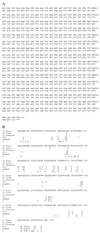Selective serotonin reuptake inhibitors directly alter activity of neurosteroidogenic enzymes
- PMID: 10557352
- PMCID: PMC23979
- DOI: 10.1073/pnas.96.23.13512
Selective serotonin reuptake inhibitors directly alter activity of neurosteroidogenic enzymes
Abstract
The neurosteroid 3alpha-hydroxysteroid-5alpha-pregnan-20-one (allopregnanolone) acts as a positive allosteric modulator of gamma-aminobutyric acid at gamma-aminobutyric acid type A receptors and hence is a powerful anxiolytic, anticonvulsant, and anesthetic agent. Allopregnanolone is synthesized from progesterone by reduction to 5alpha-dihydroprogesterone, mediated by 5alpha-reductase, and by reduction to allopregnanolone, mediated by 3alpha-hydroxysteroid dehydrogenase (3alpha-HSD). Previous reports suggested that some selective serotonin reuptake inhibitors (SSRIs) could alter concentrations of allopregnanolone in human cerebral spinal fluid and in rat brain sections. We determined whether SSRIs directly altered the activities of either 5alpha-reductase or 3alpha-HSD, using an in vitro system containing purified recombinant proteins. Although rats appear to express a single 3alpha-HSD isoform, the human brain contains several isoforms of this enzyme, including a new isoform we cloned from human fetal brains. Our results indicate that the SSRIs fluoxetine, sertraline, and paroxetine decrease the K(m) of the conversion of 5alpha-dihydroprogesterone to allopregnanolone by human 3alpha-HSD type III 10- to 30-fold. Only sertraline inhibited the reverse oxidative reaction. SSRIs also affected conversions of androgens to 3alpha- and 3alpha, 17beta-reduced or -oxidized androgens mediated by 3alpha-HSD type II(Brain). Another antidepressant, imipramine, was without any effect on allopregnanolone or androstanediol production. The region-specific expression of 3alpha-HSD type II(Brain) and 3alpha-HSD type III mRNAs suggest that SSRIs will affect neurosteroid production in a region-specific manner. Our results may thus help explain the rapid alleviation of the anxiety and dysphoria associated with late luteal phase dysphoria disorder and major unipolar depression by these SSRIs.
Figures




References
-
- Compagnone, N. A. & Mellon, S. H. (1999) Front. Neuroendocrinol., in press. - PubMed
-
- Mensah-Nyagan A G, Do-Rego J-L, Luu-The V, Pelletier G, Vaudry H. Pharmacol Rev. 1999;51:63–81. - PubMed
-
- Baulieu E E. Biol Cell. 1991;71:3–10. - PubMed
-
- Mellon S H. J Clin Endocrinol Metab. 1994;78:1003–1008. - PubMed
-
- Harrison N L, Simmonds M A. Brain Res. 1984;323:287–292. - PubMed
Publication types
MeSH terms
Substances
Associated data
- Actions
Grants and funding
LinkOut - more resources
Full Text Sources
Other Literature Sources
Molecular Biology Databases

